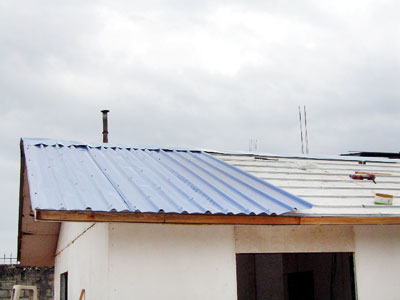Roofing industry intensifies protest against proposed asbestos ban
While there is no scientific explanation for the proposed ban on the use of asbestos, the economic fall-out from a ban would cost around Rs. 3 billion with many Sri Lankans losing their job, according to opponents of the ban.

File picture of roofing sheets
In a recent interview with the Business Times, Anton Edema, Coordinator, Chrysotile Information Centre (CIC) – Fibre Cement Products Manufacturers Association (FCPMA), said that there is no basis or reason for a ban, but was based on “one person’s ‘decision”. He didn’t elaborate but the reference was clearly to President Maithripala Sirisena.
The impeding ban has been the focus of attention of protesting manufacturers and others of the anti-ban lobby arguing that while the economy will suffer, the socio economic impact would be disastrous.
Mr. Edema said a ban will affect around 200,000 direct and indirect jobs with the industry contributing 3 per cent to the GDP.
Though the government speaks of a ban, it has not given any tangible reason for such a ban. The only reason given is that the World Health Organisation (WHO) has indicated certain things and the fact that around 55 countries have banned the product. Yet, he pointed out that more than 150 countries still use asbestos roofing material.
He said that the ban in the 55 countries would be due to the use of harmful asbestos, something called ‘friable’ which is the raw form of asbestos. But in the case of Sri Lanka, the local industry has been using Chrysotile for the last 70 years which has no reported health hazards so far.
The government has not officially notified the industry of a ban. According to a cabinet decision on September 16, 2016, a Committee was appointed and charged with the responsibility of developing a methodology to switch over to the use of substitutes already identified by local and foreign research.
The factories that are already manufacturing asbestos roofing sheets were to be asked to be converted to make non-asbestos products, following this research and recommendations.
However, he said, this committee is yet to come up with their recommendations. He said that the negative effects in the use of asbestos emerged in the 1920s in the garment industry where some lung related diseases were identified during a time when two types of asbestos – Amphibole and Serpentine – were being used.
While Amphibole was found to contain cancer-causing properties, Serpentine (Chrysotile) is considered safe. Some people are reported to have died in Poland through various diseases caused by asbestos there were no deaths due to the use of Chrysotile. He said health-hazard free roofing sheets are used in Sri Lanka and challenged the authorities to prove otherwise.
He said that in the world 45 per cent use Chrysotile (asbestos) roofing while in Sri Lanka it is 35 per cent. Almost the entire world, including Sri Lanka uses the asbestos mined in Russia – around 2 million tons per annum. In Sri Lanka there are four factories.


